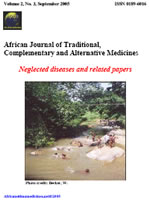
|
African Journal of Traditional, Complementary and Alternative Medicines
African Ethnomedicines Network
ISSN: 0189-6016
Vol. 14, No. 1, 2017, pp. 138-144
|
 Bioline Code: tc17015
Bioline Code: tc17015
Full paper language: English
Document type: Research Article
Document available free of charge
|
|
|
African Journal of Traditional, Complementary and Alternative Medicines, Vol. 14, No. 1, 2017, pp. 138-144
| en |
ANTHELMINTIC EFFECTS OF DRIED GROUND BANANA PLANT LEAVES ( MUSA  SPP.) FED TO SHEEP ARTIFICIALLY INFECTED WITH HAEMONCHUS CONTORTUS SPP.) FED TO SHEEP ARTIFICIALLY INFECTED WITH HAEMONCHUS CONTORTUS  AND TRICHOSTRONGYLUS COLUBRIFORMIS AND TRICHOSTRONGYLUS COLUBRIFORMIS 
Gregory, Lilian; Yoshihara, Eidi; Silva, Leandro Kataoaka Fernandes; Marques, Eduardo Carvalho; Ribeiro, Bruno Leonardo Mendonça; Meira Júnior, Enoch Brandão de Souza; Rossi, Rodolfo Santos; Amarante, Alessandro Francisco Talamini do & Hasegawa, Marjorie Yumi
Abstract
Background: Helminths is a endoparasites that cause the major losses for profitable sheep production in Brazil. The
increased development of resistant strains of endoparasites have enforced the search for sustainable alternatives. The
aim of this paper was to provide information about endoparasites control with banana leaves in infected sheep as
alternative control strategies and see its viability.
Materials and Methods: In this study, we performed two trials to investigate the anthelmintic properties of banana
leaves on endoparasites in sheep. In Trial 1, twelve sheep were artificially infected with Trichostrongylus
colubriformis; in Trial 2, eleven sheep were artificially infected with Haemonchus contortus. Clinical examinations,
packed cell volume, total protein, faecal egg counts (FECs) and egg hatchability tests (EHTs) were performed. At the
end of the trials, the sheep were humanely slaughtered, and total worm counts were performed.
Results: In Trial 1 and 2, no significant FEC decreases were note but significant diference in EHTs were observed.
Total worm counts, clinical and haematological parameters did not reveal significant changes between the treatment
and control groups. These results suggest that feeding dried ground banana plant leaves to sheep may reduce the
viability of Trichostrongylus colubriformis eggs, and this anthelmintic activity is potentially exploitable as part of
an integrated parasite management programme.
Conclusion: However, further investigation is needed to establish the optimal dosage, develop a convenient delivery
form and confirm the economic feasibility of using banana plantation byproducts as feed for ruminant species.
Keywords
alternative parasite control; endoparasites; small ruminant
|
| |
© Copyright [2017] - African Journal of Traditional, Complementary and Alternative Medicines
Alternative site location: http://journals.sfu.ca/africanem/index.php/ajtcam
|
|
